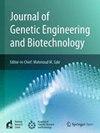ppar - α和SNP受体(Leu162Val)在急性冠脉综合征中的预后和功能作用:一个潜在的新靶点
IF 2.8
Q3 Biochemistry, Genetics and Molecular Biology
Journal of Genetic Engineering and Biotechnology
Pub Date : 2025-08-20
DOI:10.1016/j.jgeb.2025.100555
引用次数: 0
摘要
背景与目的ppar - α在急性冠脉综合征(ACS)中起关键作用。它的激活会影响脂质代谢和炎症,影响心血管健康,并可能降低与心脏病相关的风险。本研究旨在探讨ACS患者ppar - α浓度与基因多态性的关系。方法与材料本研究纳入90例ACS患者和90例30-70岁的对照组。采用ELISA和HRM-PCR检测血液中生物标志物(肌钙蛋白、CK-MB、hs-CRP、PPARα)和rs1800206 SNP。数据采用SPSS v21、方差分析和ROC检验进行统计学分析。结果患者组肌钙蛋白、CK-MB、hs-CRP水平均高于健康组,组间差异有统计学意义(p值<;0.05)。患者ppar - α水平低(1472.2±74.5),健康组ppar - α水平高(2051.8±149.9),组间差异有统计学意义。ROC分析发现CK-MB和hs-CRP是ACS诊断的最佳生物标志物;PPARα具有良好的预测价值。该研究还发现,与健康组不同,显性基因型(CC)在患者样本中所占比例很小,而纯合子(CG)和隐性基因型(GG)所占比例最高。在考虑G等位基因为危险因素时,等位基因(C)在患者组中的百分比较低,而等位基因(G)在患者组中的百分比较高。此外,Hardy-Weinberg平衡呈异常分布,表明群落外因素的存在改变了遗传模式。结果还表明,显性遗传模型在伊拉克社区感染ACS的样品中表现最好。结论ppar - α浓度与Leu162Val (rs1800206) SNP遗传多态性与急性冠状动脉综合征存在一定的关系,且ppar - α浓度降低,且隐性基因和隐性等位基因在患者中较健康人群占优势。本文章由计算机程序翻译,如有差异,请以英文原文为准。
Prognostic and functional role of PPAR-alpha and SNP receptor (Leu162Val) in acute coronary syndrome: a potential novel target
Background and objective
PPAR-alpha plays a key role in acute coronary syndrome (ACS). Its activation influences lipid metabolism and inflammation, impacting cardiovascular health and potentially mitigating risks related to heart conditions. This study aims to find the relationship between PPAR-alpha concentration and genetic polymorphism in ACS patients.
Methods and materials
The study enrolled 90 ACS patients and 90 controls aged 30–70. Blood samples were analyzed for biomarkers (troponin, CK-MB, hs-CRP, PPARα) and rs1800206 SNP via ELISA and HRM-PCR. Data were statistically analyzed using SPSS v21, ANOVA, and ROC tests.
Results
The results showed an increase in the levels of troponin, CK-MB, and hs-CRP for the patient groups compared to the healthy groups with significant differences between the groups (p-value <0.05). The level of (PPAR-alpha) was low in patients (1472.2 ± 74.5) and high in the healthy group (2051.8 ± 149.9) with significant differences between study groups. ROC analysis identified CK-MB, and hs-CRP as optimal biomarkers for ACS diagnosis; PPARα showed good predictive value. The study also found that the dominant genotype (CC) represented a small percentage of the patient samples while the homozygotes (CG) and the recessive (GG) represented the highest percentage, unlike the healthy group. Also, Allele (C) has a low percentage in the patients’ group while allele (G) has a high percentage with considering the G allele as a risk factor. In addition, the results showed an abnormal distribution of Hardy-Weinberg equilibrium indicating the presence of factors extraneous to the community that changed the genetic pattern. The results also showed that the dominant genetic model is the best expressive for the samples of the Iraqi community infected with ACS.
Conclusions
The present study demonstrated a relationship between the concentration of PPAR-alpha and the genetic polymorphism of Leu162Val (rs1800206) SNP and acute coronary syndrome with a decrease in the concentration of PPAR-alpha and the predominance of the recessive gene and the recessive allele in patients compared to healthy individuals.
求助全文
通过发布文献求助,成功后即可免费获取论文全文。
去求助
来源期刊

Journal of Genetic Engineering and Biotechnology
Biochemistry, Genetics and Molecular Biology-Biotechnology
CiteScore
5.70
自引率
5.70%
发文量
159
审稿时长
16 weeks
期刊介绍:
Journal of genetic engineering and biotechnology is devoted to rapid publication of full-length research papers that leads to significant contribution in advancing knowledge in genetic engineering and biotechnology and provide novel perspectives in this research area. JGEB includes all major themes related to genetic engineering and recombinant DNA. The area of interest of JGEB includes but not restricted to: •Plant genetics •Animal genetics •Bacterial enzymes •Agricultural Biotechnology, •Biochemistry, •Biophysics, •Bioinformatics, •Environmental Biotechnology, •Industrial Biotechnology, •Microbial biotechnology, •Medical Biotechnology, •Bioenergy, Biosafety, •Biosecurity, •Bioethics, •GMOS, •Genomic, •Proteomic JGEB accepts
 求助内容:
求助内容: 应助结果提醒方式:
应助结果提醒方式:


